A classic triangle pattern was identified in recent analysis. Price has broken downwards out of the pattern today, which was the expected direction.
Members were advised on the 28th of November to expect downwards movement. On the 1st of December, members were given specific trading advice to enter short for either just a short position or for the short side of a hedge. Those positions should now be profitable.
Advice is given today on how to manage short positions.
Summary: Today looks like a downwards breakout. The target is at 1,191, which may be met in about four weeks time.
Short positions may be held now with stops just above 1,287.61. Any remaining long positions of a hedge may be underwater, and may be closed now if price moves reasonably below 1,262.52.
Always trade with stops and invest only 1-5% of equity on any one trade.
New updates to this analysis are in bold.
Last monthly charts for the main wave count are here, another monthly alternate is here, and video is here.
Grand SuperCycle analysis is here.
MAIN ELLIOTT WAVE COUNT
WEEKLY CHART
Both wave counts expect that Gold completed a large five down from the all time high in November 2011 to the low of December 2015, which is seen on the left hand side of both weekly charts.
If this analysis is correct, then the five down may not be the completion of the correction. Corrective waves do not subdivide as fives; they subdivide as threes. The five down is seen as cycle wave a within Super Cycle wave (a).
Both wave counts then expect cycle wave b began in December 2015.
There are more than 23 possible corrective structures that B waves may take. It is important to always have multiple wave counts when B waves are expected.
It looks unlikely that cycle wave b may have been over at the high labelled primary wave A. Primary wave A lasted less than one year at only 31 weeks. Cycle waves should last one to several years and B waves tend to be more time consuming than other Elliott waves, so this movement would be too brief for cycle wave b.
This wave count looks at cycle wave b to be most likely a regular contracting triangle.
The B-D trend line should have a reasonable slope for this triangle to have the right look, because the A-C trend line does not have a strong slope. A barrier triangle has a B-D trend line that is essentially flat; if that happened here, then the triangle trend lines would not converge with a normal look and that looks unlikely.
Primary wave D should be a single zigzag. Only one triangle sub-wave may be a more complicated multiple, and here primary wave C has completed as a double zigzag; this is the most common triangle sub-wave to subdivide as a multiple.
Primary wave D of a contracting triangle may not move beyond the end of primary wave B below 1,123.08.
At its completion, primary wave D should be an obvious three wave structure at the weekly chart level.
For this one weekly chart, three daily charts are presented below. They look at intermediate wave (B) in three different ways, and are presented now in order of probability.
DAILY CHART
All three daily charts are identical up to the low labelled intermediate wave (A).
This first daily chart shows intermediate wave (B) as a now complete regular contracting Elliott wave triangle. This has support from what looks like a classic downwards breakout from the symmetrical triangle identified on the technical analysis chart below.
The target assumes that intermediate wave (C) may exhibit the most common Fibonacci ratio to intermediate wave (A).
Intermediate wave (C) must subdivide as a five wave structure. Within intermediate wave (C), the second wave correction to come may not move beyond the start of the first wave above 1,287.61.
Intermediate wave (A) lasted twenty sessions. Intermediate wave (C) may be about even in duration as well as length, so twenty or twenty-one sessions looks likely.
HOURLY CHART
If a new trend at intermediate degree is beginning, then a five down should develop at the daily chart level. That would so far be incomplete and will be labelled here minor wave 1.
Within minor wave 1, minute wave iii may be an incomplete impulse.
Within minute wave iii, so far minuette waves (i) through to (iii) may be complete. Minuette wave (iv) may not move into minuette wave (i) price territory above 1,271.10.
So far minute wave iii fits well into an Elliott channel. If price breaks above this channel, then minute wave iii may be over and minute wave iv may have arrived. At that stage, the invalidation point must move to 1,272.05 because minute wave iv may not move into minute wave i price territory.
SECOND DAILY CHART
It is still possible that the triangle for intermediate wave (B) may not be over. It may be continuing further as a regular barrier triangle.
For a barrier triangle, minor wave D should end about the same level as minor wave B, so that the B-D trend line is essentially flat. What this means in practice unfortunately is that minor wave D can end slightly below the end of minor wave B and this wave count will remain valid.
As soon as price moves reasonably lower and the B-D trend line looks like it has a downwards slope, then this wave count must be discarded.
This is the only Elliott wave rule which is not black and white and involves an area of subjectivity.
A final upwards swing may begin now for minor wave E. Minor wave E may not move beyond the end of minor wave C above 1,298.70. Minor wave E would most likely end short of the A-C trend line.
SECOND HOURLY CHART
If the triangle is incomplete, then price must turn up here for this wave count to have the right look at the hourly chart level.
Minor wave E must subdivide as a zigzag. It may last one to a few days. Minor wave E may not move beyond the end of minor wave C above 1,298.70.
Minute wave b within minor wave D must be seen as a double combination for this wave count to work. The subdivisions fit, but it does not have a very typical look: minuette wave (y) should end about the same level as minuette wave (w), but it ends substantially lower.
THIRD DAILY CHART
It is very important to always consider an alternate when a triangle may be unfolding. Triangles are very tricky structures, and may even be invalidated after one thinks they are complete.
It is still possible that intermediate wave (B) may be completing as a flat correction.
Within the flat correction, both minor waves A and B are threes. Minor wave B has retraced more than the minimum 0.9 length of minor wave A.
Now minor wave C may be required to move price upwards to end at least above the end of minor wave A at 1,305.72 to avoid a truncation.
So far minor wave B is a 0.98 length to minor wave A. This indicates a possible regular flat correction. The most common Fibonacci ratio is used for the target for minor wave C to exhibit for a regular flat correction. Regular flats normally fit well within channels. The upper edge of the channel may be expected to provide resistance.
A new high above 1,298.70 is required now for confidence in this wave count.
ALTERNATE ELLIOTT WAVE COUNT
WEEKLY CHART
Both wave counts are identical to the low labelled cycle wave a. Thereafter, they look at different possible structures for cycle wave b.
TECHNICAL ANALYSIS
WEEKLY CHART
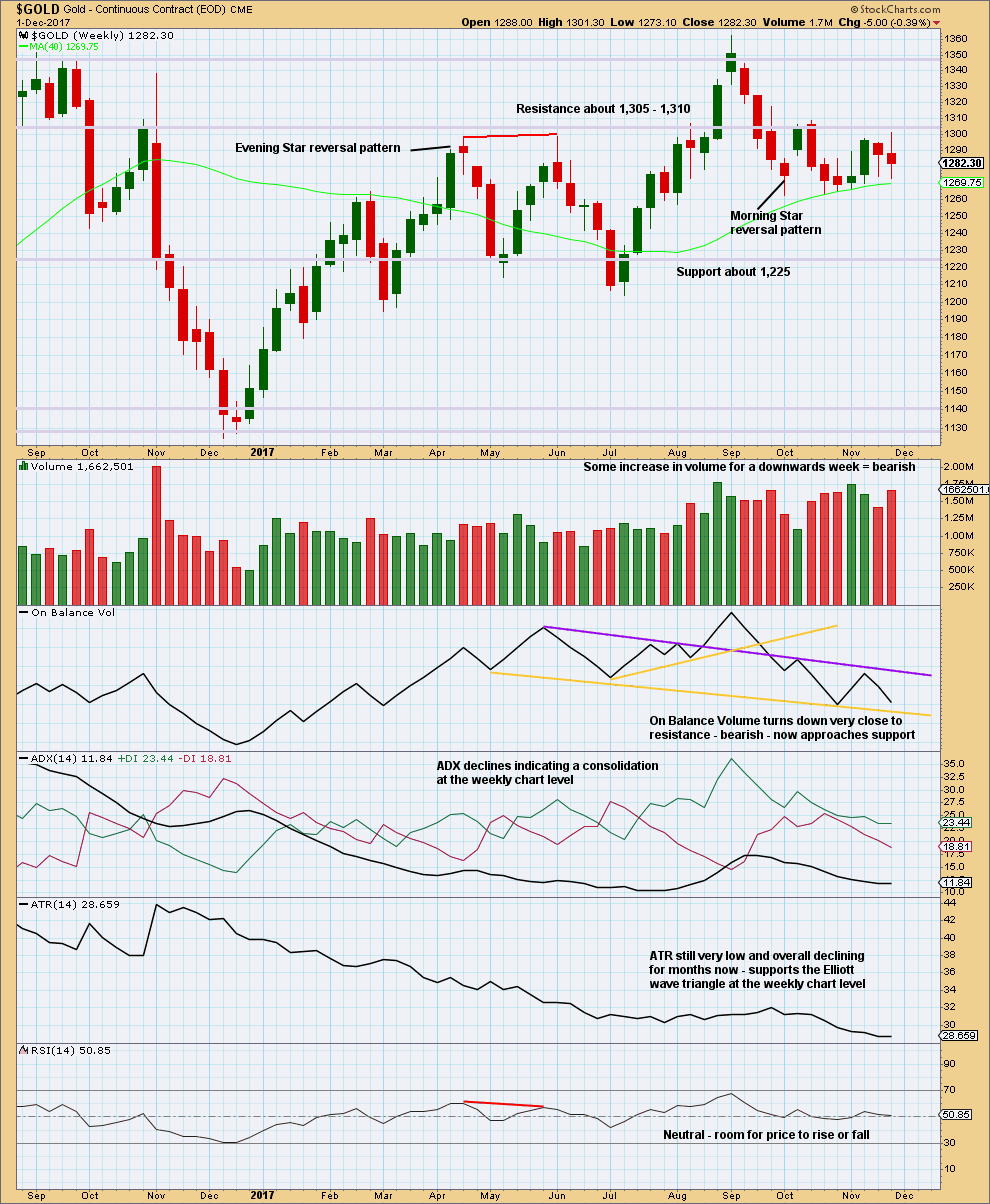
Click chart to enlarge. Chart courtesy of StockCharts.com.
On Balance Volume is still constrained. The last signal given was bearish.
DAILY CHART
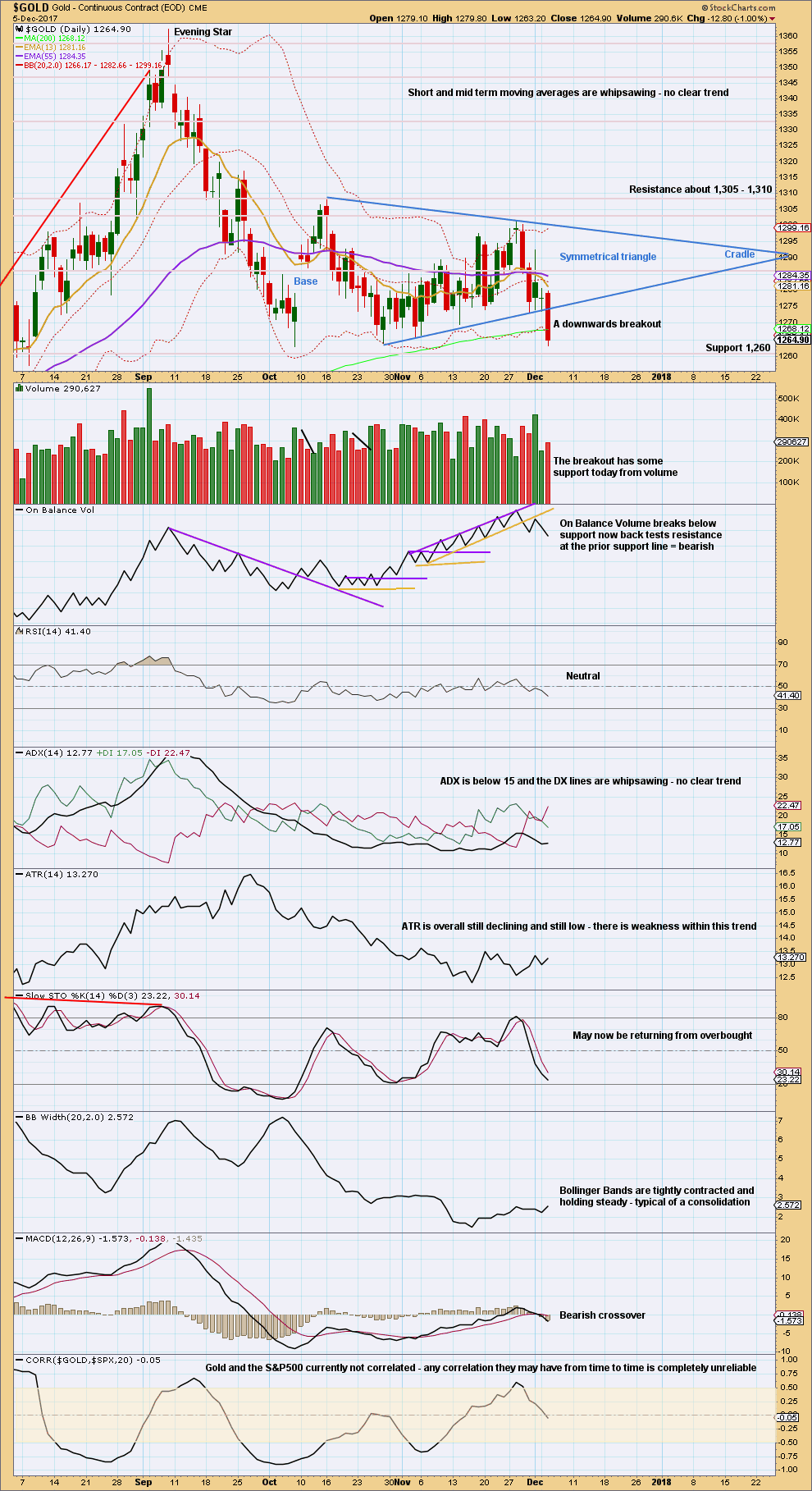
Click chart to enlarge. Chart courtesy of StockCharts.com.
Downwards movement today looks very much like a downwards breakout from a symmetrical triangle. Because the support line for the triangle was tested seven times prior to this breakout, that trend line has strong technical significance and a strong downwards day closing well below it is a strong bearish signal.
Regarding triangles from Kirkpatrick and Dhalquist:
“Throwbacks… occur 37%… of the time, respectively, and, as in most patterns, when they occur, they detract from eventual performance. This implies that for actual investement or trading, the initial breakout should be aced upon, and if a pullback or throwback occurs, the protective stop should be tightened. It does not imply that a pullback or throwback should be ignored, but that instead, performance expectations should be less than if no pullback or throwback had occurred.”
On trading triangles:
“The ideal situation for trading triangles is a definite breakout, a high trading range within the triangle, an upward-sloping volume trend during the formation of the triangle, and especially a gap on the breakout… An initial target for these patterns is calculated by adding the be distance – the vertical distance between the initial upper and lower reversal point prices – to the price where the breakout occurred.”
A target is calculated using this method today to be about 1,228.
Members are warned that a throwback to the lower trend line of the triangle is unlikely. The breakout should be acted upon.
Always remember to manage risk as the most important aspect of trading. Always use a stop and invest only 1-5% of equity on any one trade.
GDX DAILY CHART

Click chart to enlarge. Chart courtesy of StockCharts.com.
A descending triangle looks to be forming now for GDX. From Kirkpatrick and Dhalquist regarding descending triangles:
“The breakout is more common to the downside (65%), but the upward breakout is more reliable and profitable… This formation can be stretched high and wide and is sometimes difficult to recognise. The trend lines defining its boundaries are almost never exact and are loaded with false intra-bar breakouts. A strict breakout strategy is required… However, prices often explode out of it and produce sizeable gains. It can also be wild and guarantee an exciting ride. It will break out and run, break out and pull back to its trend line, break out and pull back to its cradle, or break back through the cradle, create a sizeable trap, and then reverse back in its original breakout direction and run. In other words, when you enter on a breakout from a descending triangle, the subsequent action must be watched carefully.”
Today looks like a downwards breakout from this triangle, with some support from volume and a small gap down. This breakout should be acted upon if members do not already hold short positions.
A target calculated from the width of the triangle and applied to the breakout point is at 20.43.
For the short term, with bearish volume, On Balance Volume and ADX, it looks like GDX may move lower tomorrow.
Published @ 10:05 p.m. EST.

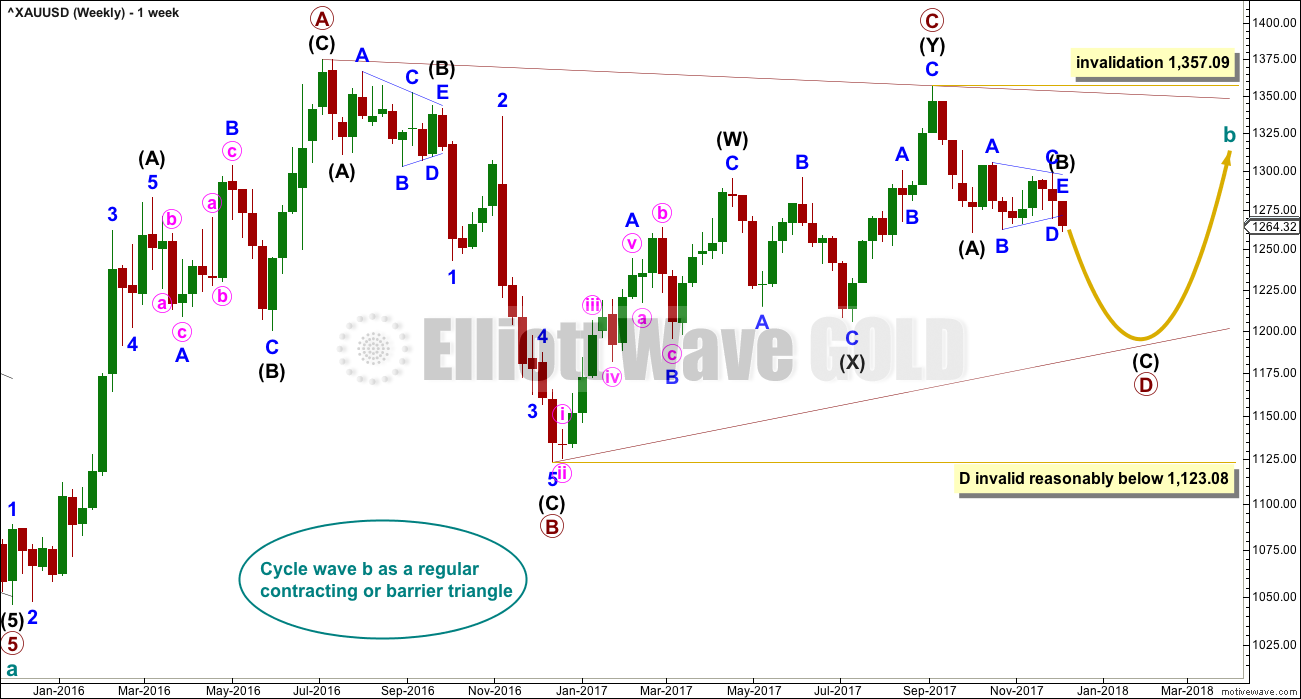
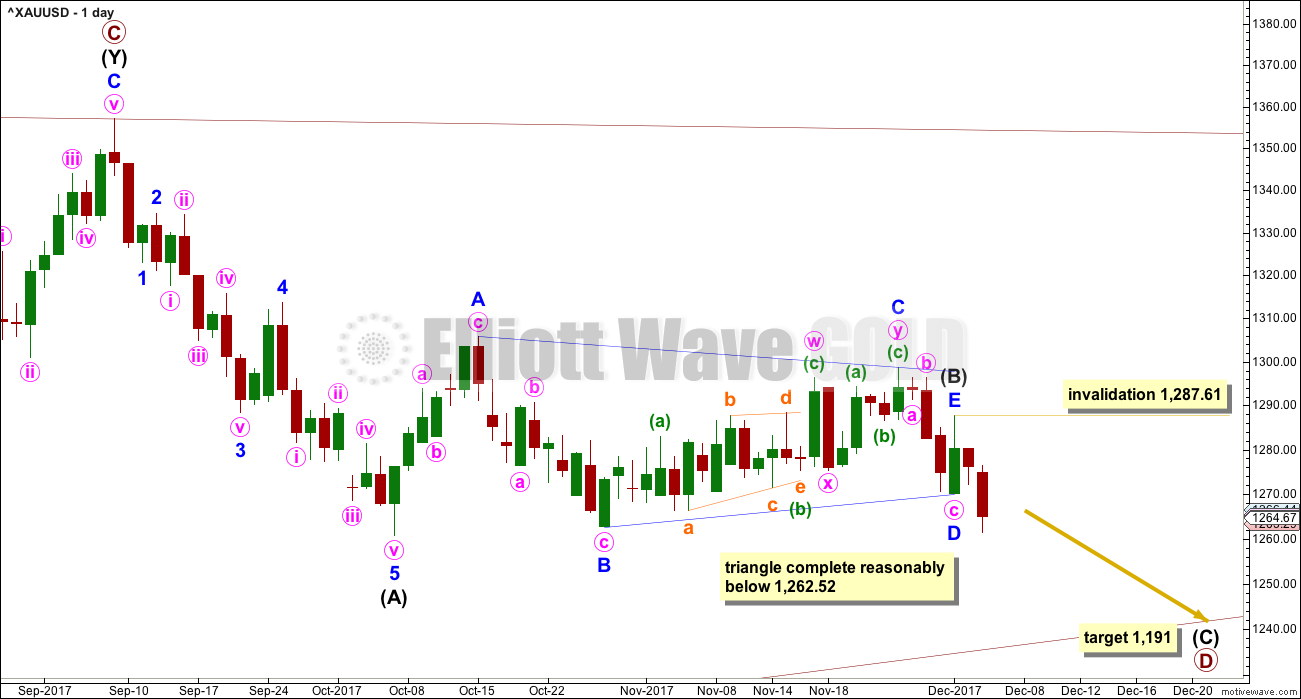

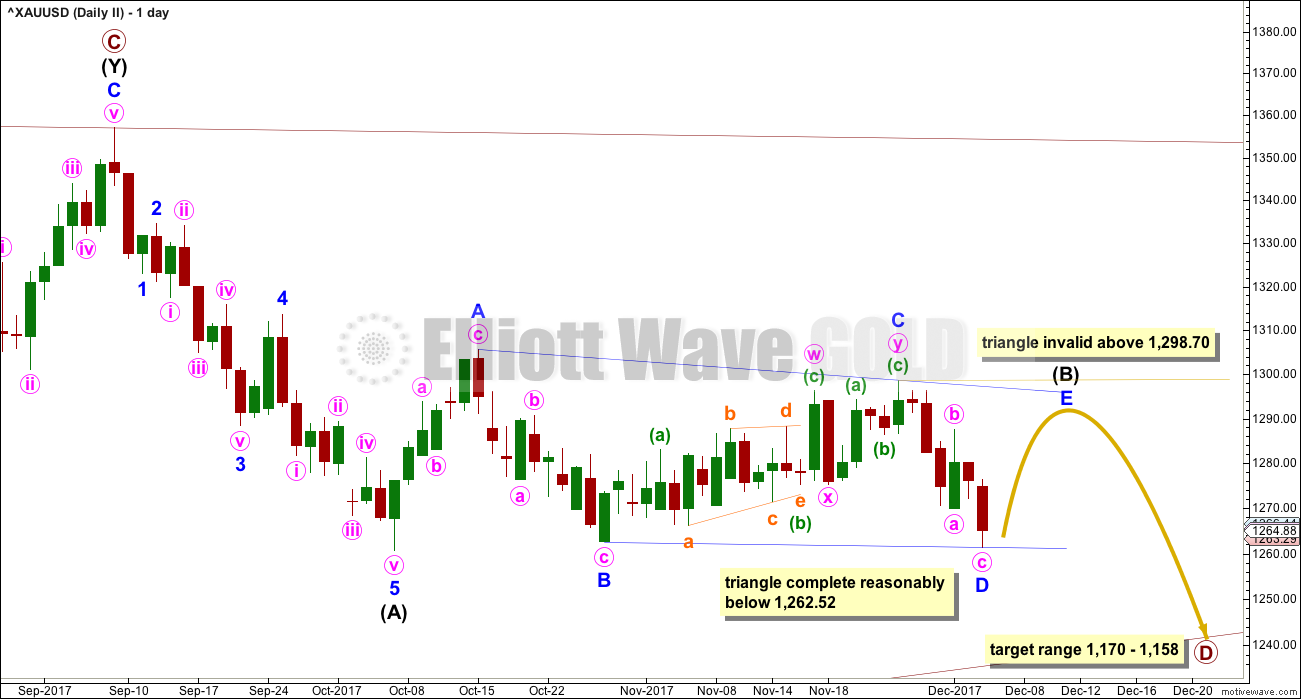
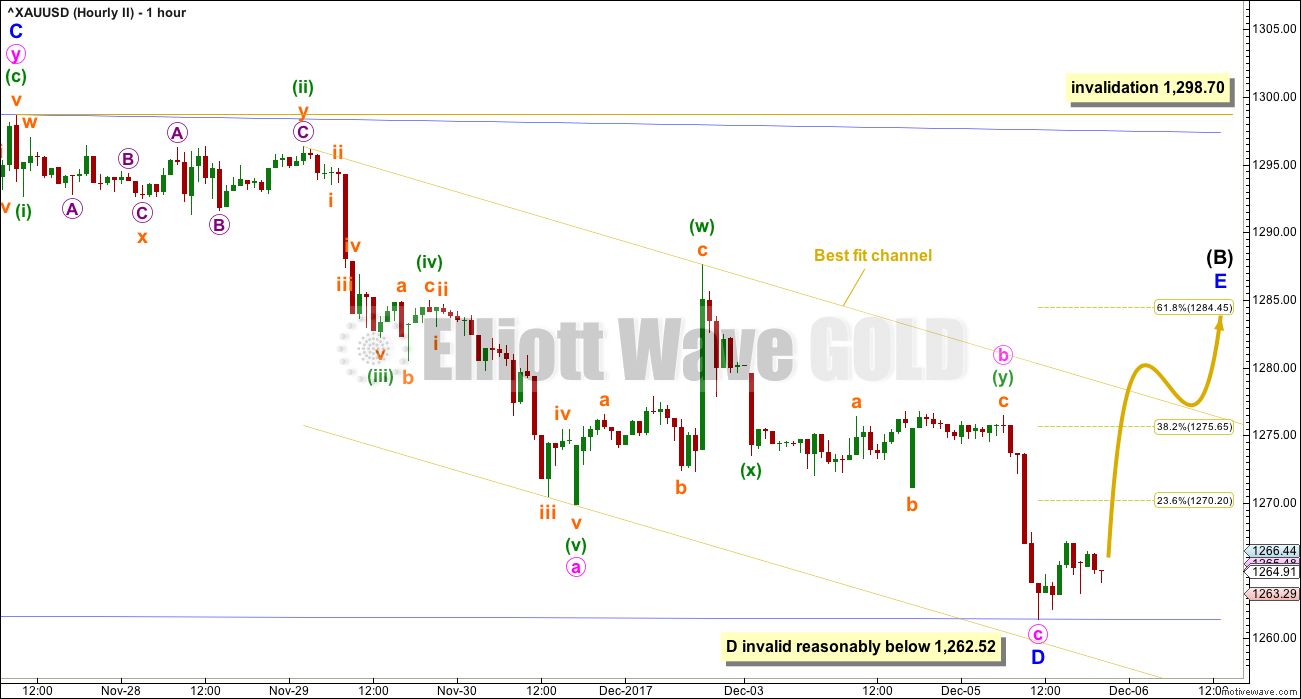
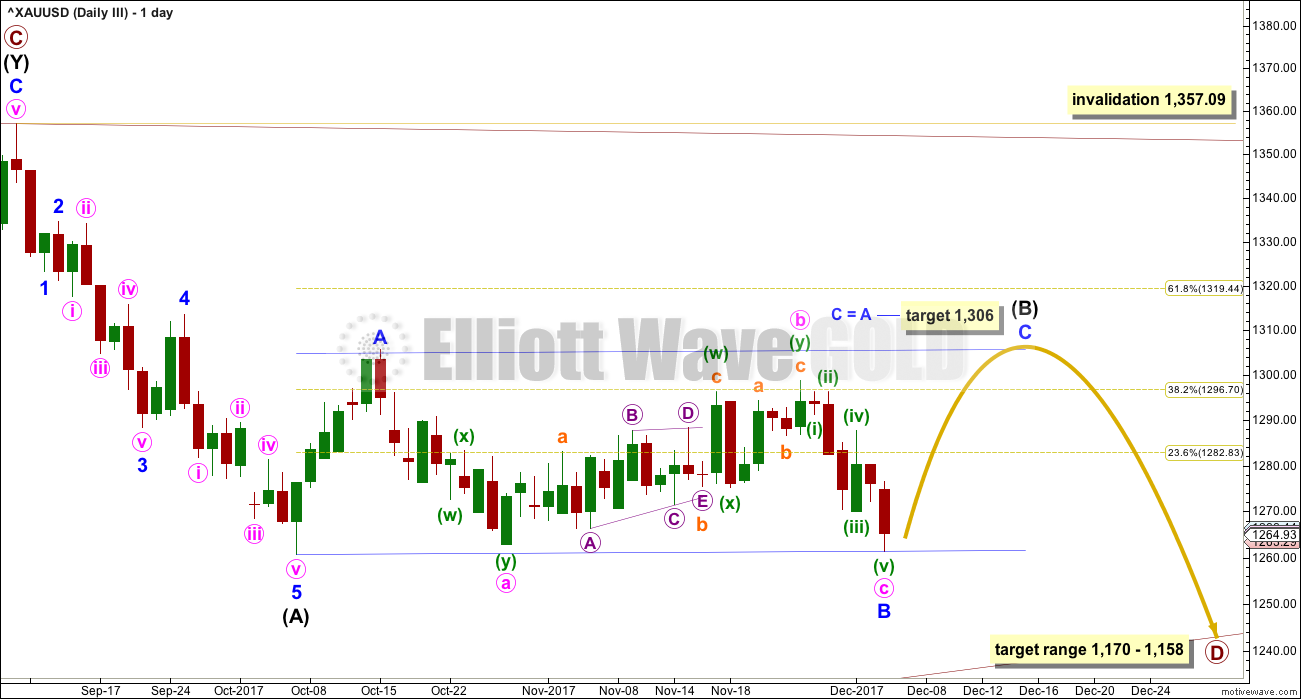
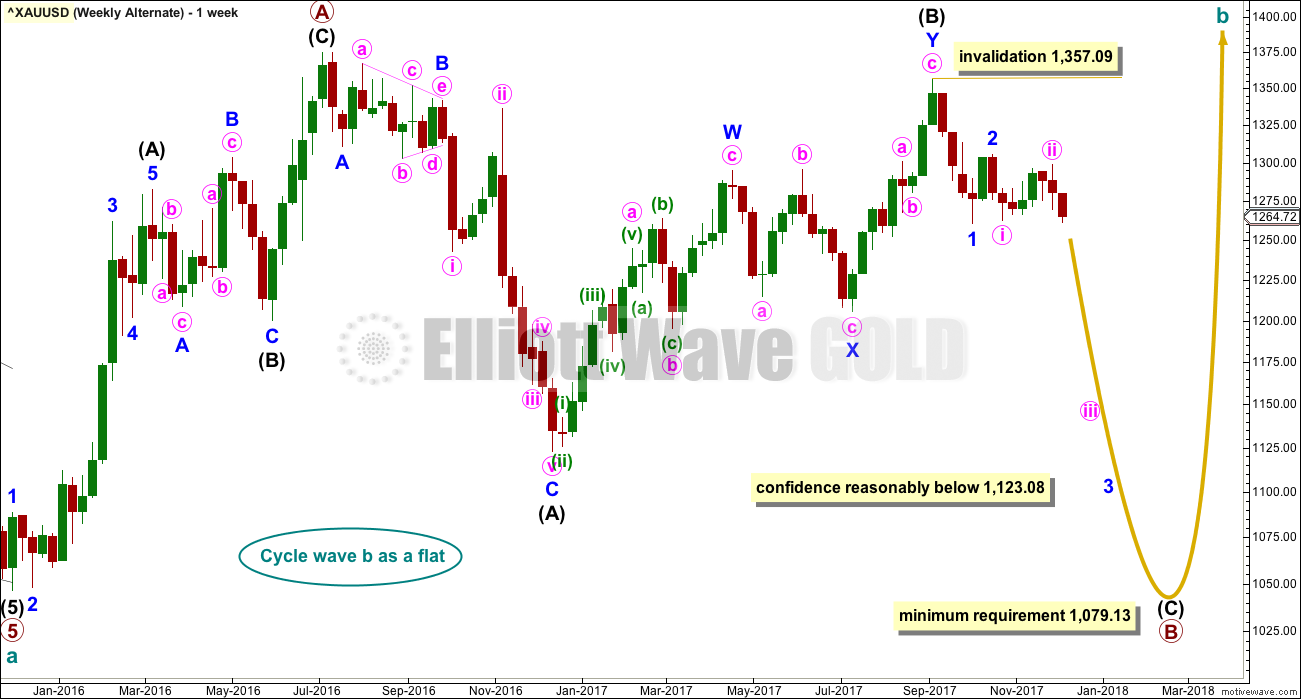
With a new low now reasonably below 1,262.50 the second daily and hourly charts may be discarded.
If intermediate (B) was a triangle, then it’s over.
The third wave count remains valid though. Intermediate (B) could be continuing as a flat correction. I’ll be using technical analysis of volume in particular to judge the probability of these two wave counts today.
Updated main hourly chart:
A five down not yet complete. The fourth wave moved out of the Elliott channel drawn using the first technique. Fourth waves aren’t always contained in those channels which is why Elliott developed a second technique to redraw the channel. That’s done here.
Look for the fifth wave to end about mid way in this channel.
Minuette (iii) has a very close Fibonacci ratio to minuette (i). So minuette (v) may not exhibit a ratio to either of (i) or (iii).
If it were to it may now be about equal in length with minuette (iii) at 1,254.
Similar Bullish divergences in play for the juniors
Last call for the GDX bullish triangle set-up.
Lara thinks that wave E of the triangle has overshot the A-C trendline too much for “the right look” although no rules are broken yet
RSI and Stochastics show bullish divergence with price now, but that could evaporate if price continues strongly lower
Price closed below the lower Bollinger Band. Either it snaps back into the band and goes higher or it rides the band down
Volume has been in decline all year. A breakout recognition day is due
OBV is at multi-month support. It’s a must for the bulls that this holds
Tomorrow is another day…
That divergence is looking pretty bullish there Dreamer. And that’s a nice support line for price you have there too. I’ll add those both to the TA chart for GDX today. Thank you!